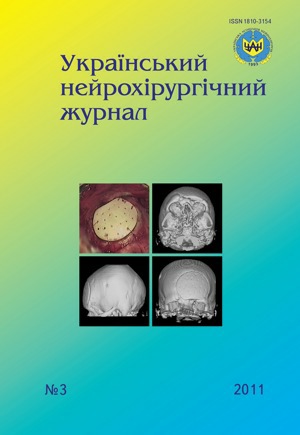Influence of liposome-mediated APOE3 gene transfection of brain tissue on diffuse axonal injury, caused by traumatic brain injury, in experiment
DOI:
https://doi.org/10.25305/unj.57795Keywords:
traumatic brain injury, gene therapy, apolipoprotein E, diffuse axonal injuryAbstract
The goal of study was to estimate the structural damage of axons in rats with severe traumatic brain injury (TBI), and the possibilities of such disorders correction by means of gene therapy that launches the synthesis of e3 isoform of apolipoprotein E in brain tissue. Severe diffuse TBI in rats was inflicted under overall anesthesia by free load weighing 450 g, falling from a 1.5 m elevation. The mixture of DOTAP liposome and 25 µg of plasmid vector pCMV•SPORT6 with cDNA of APOE3 gene was infused intraventricularly using ALZET osmotic pumps. Severe experimental TBI is characterized by the damage of hippocampal cytoarchitectonics with destructive-dystrophic changes of all brain elements (neurons, glia, capillaries). The distinguishing feature of this damage is diffuse axonal injury exhibited by pronounced changes of axonal cytoskeleton, axonal edema and deformity, mitochondrial destruction and serious damage to myelin sheathes. The liposome-mediated brain tissue transfection with plasmid vector carrying the gene of e3 isoform of apolipoprotein E has a positive therapeutic effect after TBI including the decrease of diffuse axonal injury.
References
Clinical trials in head injury / R.K. Narayan, M.E. Michel, B. Ansell [et al.] // J. Neurotrauma. — 2002. — V.19,N5. — P.503–557.
Johnston A.J. Advanced monitoring in the neurology intensive care unit: microdialysis / A.J. Johnston, A.K.Gupta // Curr. Opin. Crit. Care. — 2002. — V.8, N2. — P.121–127.
Maxwell W.L. A mechanistic analysis of nondisruptive axonal injury: a review / W.L. Maxwell, J.T. Povlishock, D.L. Graham // J. Neurotrauma. — 1997. — V.14. — P.419–440.
Park E. Traumatic brain injury: Can the consequences be stopped? / E. Park, J.D. Bell // C.M.A.J. — 2008. — V.178, N9. — P.1163–1170.
Wang H.-C. Experimental models of traumatic axonal injury / H.-C. Wang, Y.-B. Ma // J. Clin. Neurosci. — 2010. — V.17. —P.157–162.
Влияние трансфекции гена аполипопротеина Е человека на структуру гиппокампа и когнитивные нарушения после черепно-мозговой травмы у крыс разного возраста / С.А. Михальский, В.В. Белошицкий, Л.А. Цыба [и др.] // Пробл. старения и долголетия. — 2008. — Т.17, №2. — С.240–258.
Влияние липосомальной трансфекции гена аполипопротеина Е3 на динамику неврологического и когнитивного дефицита при черепно-мозговой травме в эксперименте / В.В. Белошицкий, Н.Я. Гридина, Цыба Л.А., Величко О.Н. // Укр. нейрохірург. журн. — 2009. — №2. — С. 59–60.
Вплив ліпосомальної трансфекції в клітини головного мозку гену апоЕ3 на дослідницьку поведінку та емоційний стан щурів після експериментальної черепно-мозкової травми / В.В. Білошицький, О.М. Величко, Н.Я. Гридіна [та ін.] // Укр. нейрохірург. журн. — 2010. — №2. — С.55–62.
Acute subdural hematoma and diffuse axonal injury after severe head trauma / J. Sahuquillo-Barris, J. Lamarca-Ciuro, J. Vilalta-Castan [et al.] // J. Neurosurg. — 1988. — V.68. — P.894–900.
Axonal injury: a universal consequence of fatal closed head injury? / S.M. Gentleman, G.W. Roberts, T.A. Gennarelli [et al.] // Acta Neuropathol. (Berl.). — 1995. — V.89. — P.537–543.
Reinert M.M. Clinical trials in head injury / M.M. Reinert, R. Bullock // Neurol. Res. — 1999. — V.21. — P.330–338.
Immediate coma following inertial brain injury dependent on axonal damage in the brainstem / D.H. Smith, M. Nonaka, R. Miller [et al.] // J. Neurosurg. — 2000. — V.93. — P.315–322.
Ultrastructural evidence of axonal shearing as a result of lateral acceleration of the head in non-human primates / W.L. Maxwell, C. Watt, D.I. Graham [et al.] // Acta Neuropathol. (Berl.). — 1993. — V.86. — P.136–144.
Traumatic axonal injury induces calcium influx modulated by tetrodotoxin-sensitive sodium channels / J.A. Wolf, P.K. Stys, T. Lusardi [et al.] // J. Neurosci. — 2001. — V.21. — P.1923–1930.
Buki A. All roads lead to disconnection? Traumatic axonal injury revisited / A. Buki, J.T. Povlishock // Acta Neurochir. (Wien). — 2006. — V.148. — P.181–194.
Toxic proteins released from mitochondria in cell death / X. Saelens, N. Festjens, L. Vande Walle [et al.] // Oncogene. — 2004. — V.23. — P.2861–2874.
The role of calpain-mediated spectrin proteolysis in traumatically induced axonal injury / A. Buki, R. Siman, J.Q. Trojanowski, J.T. Povlishock // J. Neuropathol. Exp. Neurol. — 1999. — V.58. — P.365–375.
Apoptotic and antiapoptotic mechanisms after traumatic brain injury / R.W. Keane, S. Kraydieh, G. Lotocki [et al.] // J. Cereb. Blood Flow Metab. — 2001. — V.21, N10. — P.1189–1198.
Apolipoprotein E-genotype dependent hippocampal and cortical responses to traumatic brain injury / F. Crawford, M. Wood,S. Ferguson[et al.] // Neuroscience. — 2009. — V.159. — P.1349–1362.
Apolipoprotein E-containing lipoproteins protect neurons from apoptosis via a signaling pathway involving low-density lipoprotein receptor-related protein-1 / H. Hayashi, R. B. Campenot, D.E. Vance, J.E. Vance // J. Neurosci. — 2007. — V.27, N8. — P.1933–1941.
Downloads
Published
How to Cite
Issue
Section
License
Copyright (c) 2011 Vadym Biloshytsky, Sergey Mikhalsky, Tatyana Kvitnitskaya-Ryzhova

This work is licensed under a Creative Commons Attribution 4.0 International License.
Ukrainian Neurosurgical Journal abides by the CREATIVE COMMONS copyright rights and permissions for open access journals.
Authors, who are published in this Journal, agree to the following conditions:
1. The authors reserve the right to authorship of the work and pass the first publication right of this work to the Journal under the terms of Creative Commons Attribution License, which allows others to freely distribute the published research with the obligatory reference to the authors of the original work and the first publication of the work in this Journal.
2. The authors have the right to conclude separate supplement agreements that relate to non-exclusive work distribution in the form of which it has been published by the Journal (for example, to upload the work to the online storage of the Journal or publish it as part of a monograph), provided that the reference to the first publication of the work in this Journal is included.









